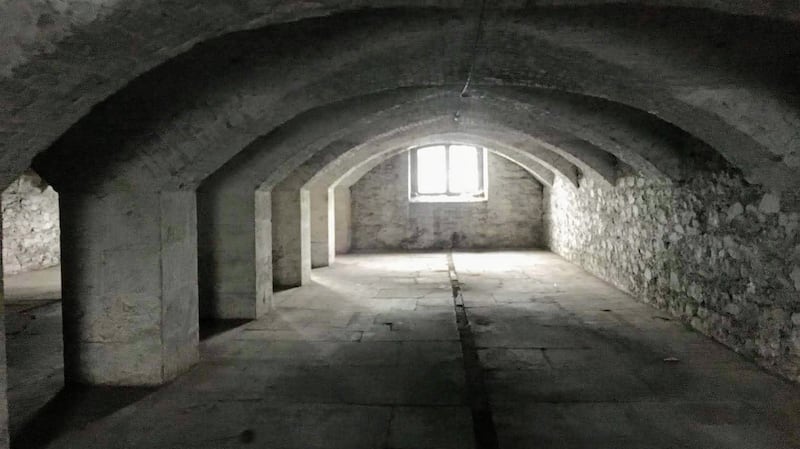"It's almost Cistercian," murmurs Katherine McClatchie as she surveys the vaulted arcades of the Cork bonded warehouses.
It's true; her lowered voice reflects the quiet in which we wander around this prized building slanted at the apex of Custom House Quay where plans for the highest tower in Ireland have been approved. With typical local chauvinism, attention to that 34-storey "slender sculpted tower" by Marco Gamini for Gensler Architects has overshadowed most of the rest of the €150 million worth of associated projects for this dramatic promontory.
Released with the removal of the Port of Cork Company's (POCC) functions to its deepwater facilities in the lower harbour, the location has its place in the multifaceted, multipractice collaborative realignments of the Cork docks. From all that is promised here, the bonded warehouses emerge as what Conor Lee, director of operations (Ireland) for developers Tower Holdings Ltd, agrees will be like a gift to the city: a museum and visitor centre celebrating Cork's long seafaring story from which its merchant princes grew into their own legends.

"The wealth of material available is unbelievable," says Lee , remarking on the research by conservation consultants Gareth O'Callaghan and McClatchie of JCA Architects and of marine consultant Capt Michael McCarthy.
“The building won’t be sanitised. We have a commitment to inner-city living and intend to keep a strong water-based activity here.”

While the area available for the tower means this plot does not suit a residential element, Lee believes the warehouse scheme conveys a sense of a young city with a potential for about 20,000 people living in the docklands precinct. He only has to gesture from this cobblestone wharf on the south channel of the river to Horgan’s Quay on the north channel to endorse his point: there O’Mahony Pike Architects lead the process, uniting several design practices in a mixed scheme which includes their own office accommodation for 3,600 staff as well as a residential grouping of 302 apartments.
Described by OMP as an arrangement of 108 one-bed and 194 two-bed balconied units, this sits within an overall plan taking in the redundant yards, sheds and spaces of Kent railway station. The setting for this rental accommodation is a courtyard entrance via the former station master’s house with a waterfront aspect offering views over the river.

The residential potential here and downstream arouses the enthusiasm of Catherine McAuliffe of Savills Ireland.
“The Horgan’s Quay apartments are high-rise and high-spec, overlooking the water and A-rated – they’d be first out of the block,” she says. McAuliffe’s assessment of a city, as well as its port, moving downstream also reflects something of the expectation prompted by the land not only at the city docks, but at the 153 acres to be freed for development with the eventual closure of the POCC terminal at the suburb of Tivoli, four kilometres away.
With the prospect of 3,000 new homes and engagement with the local and national planning framework, Tivoli is on the regeneration map
The several expert examinations of Tivoli Dock and Industrial Estate, beginning in 2017 with the RAIA report for the port company – Tivoli: A New Perspective – all expand on the inevitably complex financial, social and environmental issues to be decided before what the report envisages as a “vibrant new urban living and working quarter” can be achieved at this location. Supported by urban regeneration funding in 2019, the POCC engaged both Savills and urban design specialists Tyrens Reddy to prepare long-term options in a context of regional development and Government policy objectives for Ireland 2040.
With the prospect of 3,000 new homes and engagement with the local and national planning framework, Tivoli is on the regeneration map, loaded with the possibilities of a legacy landscape caught between wooded hills and widening river. It was from those hillside glades of Tivoli and Montenotte that Cork’s merchant princes watched the sloops, the barques, brigantines and schooners and later the bulk-carriers, ferries and even occasional liners tie up at the warehouses, unloading or taking on their cargoes.

A record of Cork’s port and harbour wrecks and losses from the 18th to the 20th centuries speaks of “this vessel of Valparaiso”, of the passage from Liverpool to Alexandria, from Constantinople to Cork, from the Americas, Jamaica and Barbados, of such destinations as Adelaide or Odessa and of Moulmein, a port in Myanmar once known as Mandalay, familiar to Rudyard Kipling in his Burma days.

Despite the sense of a monastic undercroft with the turrets, cantilevered spiral staircases and stone-flagged flooring of the warehouses, there may have been little or nothing monastic about the fine residences of the families who ruled these docks for several centuries (although Ennismore, once home to the ship-owning Leycester family, is now a Dominican retreat centre). When the developers of Horgan’s Quay chose rather daringly to give the site’s address as Montenotte they were curving geography to evoke a familiar elite, an idea of inherited grandeur emanating from the gardens and mansions once described by DL Kelleher as “laburnum villa on Italian Montenotte”. Among them was Woodhill, home of the Penrose family to whom the last despairing letters of Sarah Curran were addressed and whose name is retained on another adjacent quayside linking the docks to the avenues stretching above the river and along the increasingly vulnerable protected ridge towards Glanmire and Dunkettle.
At the warehouses we are offering the city ownership again
“Vulnerable” is also the word used by Katherine McClatchie, who regards the restoration of the warehouses as reinforcing their integration into the maritime consciousness of the city, and as a reclamation of its public spaces. Blessedly avoiding the perhaps overgenerous archispeak of “the public realm”, she notes instead the remnant witnesses of function in the winches, hoist bays and pulleys; the patterned cobblestones to be retained, the awnings to be restored, the king-post roof which O’Callaghan says will be raised as a clerestory. This approach reflects the heritage significance of the buildings included in the report by industrial archaeologist Fred Hammond in the final warehouse conservation plan prepared by JCA Architects.
The competition for a design for this exceptional site was won by Abraham Hargrave in 1808; the new plan emphasises how the passage of time has established the building as a physical manifestation of the maritime trade crucial to the development of the city of Cork, integral to the cultural landscape of the river Lee and in its location, form and materials, a focus for public affection.

Now, for the first time in 200 years, it will open to visitors as further evidence of Tower Holding’s theme of hospitality markedly displayed in the five-star, 240-bed hotel element of the tower and, appropriately enough, given the purpose of the warehouses, in the adjacent new distillery.
“Our site centres on the future of hospitality,” says Conor Lee. “At the warehouses we are offering the city ownership again, and our intention is to keep the quays as busy and active as in the past.”





















